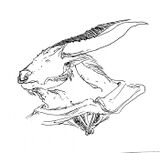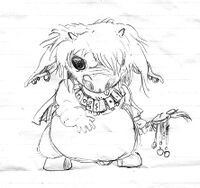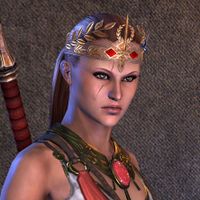Lore:Belharza
| Emperor Belharza the Man-Bull | |||
|---|---|---|---|
 Sketch of Emperor Belharza wearing the Amulet of Kings Sketch of Emperor Belharza wearing the Amulet of Kings
|
|||
| Race | Minotaur | Gender | Male |
| Born | First Era |
||
| Resided in | Cyrod | ||
| Reign | 1E 266- |
||
| Previous Ruler | Alessia | ||
| Next Ruler | Ami-El | ||
Belharza the Man-Bull was the son of the Empress Alessia and her consort, the demigod Morihaus, and one of the first minotaurs.[1] He succeeded his mother as ruler of the Alessian Empire upon her death in 1E 266. Little is known about the emperor's life and reign as most records of the period were destroyed following the rise of the Alessian Order.[1] Private correspondence between Belharza and Alessia is held in the Library of Dusk in Coldharbour, though its contents are unspecified.[2] According to some scholars, the curvature of Belharza's horns (infamously depicted in Tertia Gallus's heretical renderings circa 1E 1300) are one of the only aesthetic features that sets him apart from Morihaus.[3] He was said to have wielded a weapon called the Axe of Belharza.[4] It was theorized that early Alessian priests might have honored him and his father with sacramental oils.[5] It was speculated by some scholars that legends about Belharza were topic of interest even among the Dremora.[6]
Certain sources erroneously dismiss Belharza's Minotaur origins and assert he was a Man,[5] who "met his fate at the biting-tips of Elven spears."[7] A surviving document from an Alessian Order sect indirectly implies that Belharza was troubled by large Ayleid hordes.[8] One controversial interpretation of an ancient tablet fragment called the Belharza Stone asserts that the precursors of the xenophobic Alessian Order may have openly clashed with Belharza, and violently purged the minotaurs from the Empire.[1]
Belharza's Band was a magically imbued Imperial band linked to him.[9]
Gallery[edit]
Notes[edit]
- The crown of his mother, Alessia was set with "Twin Red Diamonds, one for Herself and one for Belharza to Come, who was even then Quickening."[10]
- Ancestor moths that served under Belharza during their corporeal stage were still in use at the end of the Third Era.[UOL 1]
See Also[edit]
Books[edit]
- On Minotaurs by Nonus Caprenius, Temporarily Unaffiliated Scholar of Imperial Antiquities — A historian's theory on Minotaurs
- The Minotaur Song — An ode to the Minotaur
- The Song of Pelinal, v 10 — The remembrance of Pelinal's slaughter at Heldon's Bridge
- The Truth of Minotaurs by Tyronius Liore, Scholar of Imperial Antiquities — The dismissal of a theory surrounding the origin of Minotaurs
References[edit]
- ^ a b c On Minotaurs — Nonus Caprenius, Temporarily Unaffiliated Scholar of Imperial Antiquities
- ^ The Library of Dusk: Rare Books
- ^ Etched Silver Horns antiquity codex entry in ESO
- ^ Campaign names in ESO
- ^ a b Alessian Sacramental Oil antiquity codex entry in ESO
- ^ Bull's Head Gallery Rail antiquity codex entry in ESO
- ^ The Truth of Minotaurs — Tyronius Liore, Scholar of Imperial Antiquities
- ^ Cleansing of the Fane
- ^ Belharza's Band's antiquity in ESO
- ^ Star-Made Diamond Diadem's item description in ESO
Note: The following references are considered to be unofficial sources. They are included to round off this article and may not be authoritative or conclusive.
- ^ Nu-Mantia Intercept — Nu-Hatta

